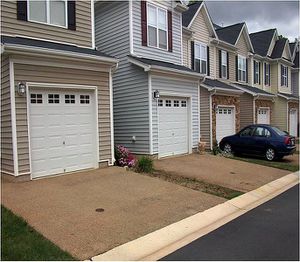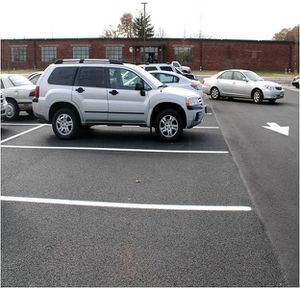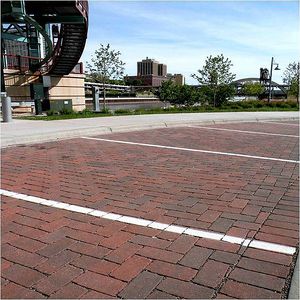
Difference between revisions of "Permeable pavement"
m |
|||
| Line 1: | Line 1: | ||
| − | |||
| − | |||
| − | |||
| − | |||
[[File:picture of porous concrete 1.jpg|thumb|300px|alt=illustration of porous concrete|<font size=2>This photo illustrates an example of pervious concrete.</font size>]] | [[File:picture of porous concrete 1.jpg|thumb|300px|alt=illustration of porous concrete|<font size=2>This photo illustrates an example of pervious concrete.</font size>]] | ||
| Line 10: | Line 6: | ||
{{alert|'''Sediment control from adjacent impervious or vegetated contributing areas is required to avoid clogging of the permeable pavement surface'''|alert-warning}} | {{alert|'''Sediment control from adjacent impervious or vegetated contributing areas is required to avoid clogging of the permeable pavement surface'''|alert-warning}} | ||
| + | |||
| + | |||
| + | '''The individual articles comprising this section on permeable pavement may be viewed as a [[permeable pavement combined|single article]].''' | ||
[[File:Picture of porous asphalt 1.jpg|thumb|300px|alt=illustration of permeable interlocking pavement|<font size=2>This photo illustrates an example of porous asphalt</font size>]] | [[File:Picture of porous asphalt 1.jpg|thumb|300px|alt=illustration of permeable interlocking pavement|<font size=2>This photo illustrates an example of porous asphalt</font size>]] | ||
| Line 20: | Line 19: | ||
<div class="center">[[Overview for permeable pavement]]</div> | <div class="center">[[Overview for permeable pavement]]</div> | ||
<div class="center">[[Types of permeable pavement]]</div> | <div class="center">[[Types of permeable pavement]]</div> | ||
| − | |||
<div class="center">[[Design criteria for permeable pavement]]</div> | <div class="center">[[Design criteria for permeable pavement]]</div> | ||
<div class="center">[[Construction specifications for permeable pavement]]</div> | <div class="center">[[Construction specifications for permeable pavement]]</div> | ||
| Line 26: | Line 24: | ||
<div class="center">[[Assessing the performance of permeable pavement]]</div> | <div class="center">[[Assessing the performance of permeable pavement]]</div> | ||
<div class="center">[[Operation and maintenance of permeable pavement]]</div> | <div class="center">[[Operation and maintenance of permeable pavement]]</div> | ||
| − | |||
<div class="center">[[Calculating credits for permeable pavement]]</div> | <div class="center">[[Calculating credits for permeable pavement]]</div> | ||
<div class="center">[[Cost-benefit considerations for permeable pavement]]</div> | <div class="center">[[Cost-benefit considerations for permeable pavement]]</div> | ||
| Line 36: | Line 33: | ||
<br> | <br> | ||
A one page [[Fact sheets for permeable pavement|fact sheet]] for permeable pavement provides overview information, a short summary of design, construction and maintenance considerations, and information on stormwater volume and pollutant removal. | A one page [[Fact sheets for permeable pavement|fact sheet]] for permeable pavement provides overview information, a short summary of design, construction and maintenance considerations, and information on stormwater volume and pollutant removal. | ||
| − | |||
| − | |||
[[category:BMP]] | [[category:BMP]] | ||
Revision as of 20:14, 21 November 2012
Permeable pavements allow stormwater runoff to filter through surface voids into an underlying stone reservoir where it is temporarily stored and/or infiltrated. The most commonly used permeable pavement surfaces are pervious concrete, porous asphalt and permeable interlocking pavers. Permeable pavements have been used for commercial and residential sites to replace traditionally impervious surfaces. These include roads, parking lots, driveways, sidewalks, plazas and patios. While the designs vary, all permeable pavements have a similar structure, consisting of a surface pavement layer, an underlying stone aggregate reservoir layer, optional underdrains and geotextile over uncompacted soil subgrade.
The reservoir thickness is determined by structural and hydrologic design analyses. From a hydrologic perspective, permeable pavement is typically designed to manage rainfall landing on the pavement surface area. It may accept runoff contributed by adjacent impervious areas such as driving lanes or rooftops. However, sediment control from adjacent impervious or vegetated contributing areas is required to avoid clogging of the permeable pavement surface.
The individual articles comprising this section on permeable pavement may be viewed as a single article.
A one page fact sheet for permeable pavement provides overview information, a short summary of design, construction and maintenance considerations, and information on stormwater volume and pollutant removal.


